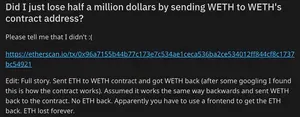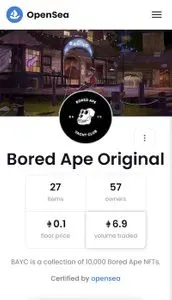Justin Bieber "buys" a Bored Ape for $1.3 million in a deal that is shady in one of two possible ways
Trader loses $510,000 trying to convert funds between two currencies
Transaction history on Etherscan shows they were the 265th person to make this mistake. Most people did so with far smaller amounts of WETH, although another unfortunate trader lost 115 WETH (at the time valued at $360,000) on August 11, 2021. A total of 432 WETH has been irretrievably lost to this contract this way since July 2018 — currently valued at $1.1 million.
Fake Bored Ape project pulls in $17,500 following high-profile endorsement of Bored Apes
Lazy Lion Ape Club rug pulls for 50 ETH ($125,000)
Khan Academy charity auction ends in blatant wash trade, and Khan Academy removing several former employees from alumni Slack channel for raising concerns
The auction ended on January 21, with a winning bid of 77 ETH (nearly $200,000) from ParagonsDAO, plus the promise of another 34 ETH ($87,000) donation from the DAO to Khan Academy. However, ParagonsDAO is a DAO created specifically to "play a key role in Parallel's governance" and "support the creation of an ecosystem for Parallel to thrive". Former Khan Academy employee S. M. Lundberg raised their concerns about the wash trading, and "KA elevat[ing] Parallel on its own channels to a largely underage and under-resourced user base" in the Khan Academy Slack, and was removed from the channel by Khan Academy founder Sal Khan. At least three other former employees were removed from the channel for criticizing the decision to engage with the NFT project, as was an additional person who protested the removal of those raising concerns.
Although the auction ended with more than $250,000 going to Khan Academy, it is likely that Parallel got the better deal here — Khan Academy is an enormous name to have promoting one's project. Sal Khan actively hyped the project in various spaces, including in an appearance on CNBC's Squawk Box.
87% of trades on LooksRare NFT platform reported to be wash trades
Wash trading is also a widespread tactic in the NFT space to artificially inflate the "value" of an NFT. Because it's relatively easy to create a pseudonymous cryptocurrency wallet, users will "sell" NFTs to themselves for large amounts to create the appearance of higher demand, and to try to convince other would-be buyers that the NFT is more valuable.










